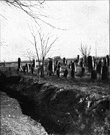World War I
Part 2: The War Begins As a result of the assassination of Archduke Franz Ferdinand in Sarajevo, a series of domino-like actions were taken:
Also at this time, the Ottoman Empire, frustrated by Austrian ambitions in the Balkans, threw in its lot with Germany and Austria-Hungary, resulting in the creation of what historians call the Central Powers. The balance of power created and enhanced by the Congress of Vienna was no more.
Germany's battle plans had included a pre-war buildup of the German Navy, so much so that the leaders of Great Britain, owners of the world's largest military fleet, were worried about German intentions in the North Atlantic. When the war began, German submarines proved very effective at interfering with British shipments of weapons and supplies to the Continent. Germany's plans on land consisted mostly of the Schlieffen Plan, named after Chief of the Imperial German Staff Count Alfred von Schlieffen. He was no longer head of the military when the war began, but his plan was still in place as what Germany considered its best option for avoiding a two-front war. The plan was to avoid the French forces massed across the Franco-German border by running around them, through neutral Belgium. The German military command reasoned that a quick victory, within six weeks, wasn't out of the realm of possibility, given the Prussian experience in both the Austro-Prussian War and the Franco-Prussian War. Germany also counted on the Russian army to take six weeks to fully mobilize its massive army, by which time Germany would have defeated France and been able to use the newly upgraded German rail network to move its military quickly from west to east. So when the war began, Germany moved quickly to implement the Schlieffen Plan, except that a modification to the preferred lightning-quick troop movements resulted in the German troops getting bogged down in northern France and unable to make major headway, certainly not within a six-week timeframe. As well, Russia mobilized its armed forces more quickly than anyone expected, causing headaches in the military commands of both Germany and Austria-Hungary. 
Germany moved one of its main armies eastward, by rail, and scored a victory at the First Battle of Tannenberg. But the delay in full implementation of the Schlieffen Plan, coupled with the loss of one of the main armies, left Germany short of a quick victory in France. German armies fought against British and French troops in a series of struggles known as the Battle of the Frontiers. The main result of all of these battles was an overall French retreat and an overall German advance. German troops continued to press their advantage into France, targeting the capital, Paris. The German advance was stopped east of Paris at the First Battle of the Marne. Allied forces drove German forces back dozens of miles. Both sides then tried to move north to outflank each other. (This was the so-called "Race to the Sea", which ended with the First Battle of Ypres.) Neither side gained an advantage until they were both out of real estate; then, both sides settled in to dig trenches. These were miles and miles of connected defensive positions, with heavily armed troops ready to fire at a moment's notice and barbed wire out front to prevent an enemy's sneak attack. 
The result was very little ground gained for most of the war. In battle after battle, both sides sent troops from defensive positions inside underground trenches into "no man's land" in hopes of taking ground away from the enemy, who were ensconced in heavily fortified positions and armed with large amounts of ammunition. Millions of men died on both sides. At Christmas during the first year of the war, both sides engaged in the Christmas Truce, a meeting in no man's land to exchange pleasantries and even play a game of soccer. It was the only such truce during the four-year-long war. Struggles for supremacy took place in the Middle East and Near East as well, with Ottoman Empire forces fighting for control of the Caucasus and the Dardanelles against Russian and U.K. troops. Russia had won territory in a number of Russo-Turkish wars in the 19th Century, and some Ottoman advances sought to recover those lands lost. As well, the Central Powers wanted control of the rich oil fields in southern Russia and in the Middle East; in particular, Ottoman troops targeted the Suez Canal. |
|
Social Studies for Kids
copyright 2002–2025
David White



 Austria-Hungary found it tough going fighting against Serbia, so much so that Austrian troops soon found themselves fighting against a determined Russia as well. When Italy joined the war on the side of the Allies, in 1915, Austrian hopes for a quick victory (indeed, for any victory) dimmed.
Austria-Hungary found it tough going fighting against Serbia, so much so that Austrian troops soon found themselves fighting against a determined Russia as well. When Italy joined the war on the side of the Allies, in 1915, Austrian hopes for a quick victory (indeed, for any victory) dimmed.
